Deț, a traditional delicacy, holds a special place in many cultures worldwide. Whether it’s enjoyed as a savory snack, a hearty meal, or a ceremonial dish, Deț encompasses not only culinary delight but also a deep-rooted cultural significance. This article embarks on a journey to unveil the rich history, cultural importance, nutritional value, and health benefits of Deț, shedding light on why this delicacy continues to captivate hearts and taste buds across different corners of the globe.
History of Deț
The origins of Deț trace back centuries, with its roots embedded in the culinary traditions of diverse cultures. The exact origin of Deț varies depending on the region, but its presence can be found in numerous ancient civilizations. From the Mediterranean to the Middle East, Asia to Africa, variations of Deț have been documented in historical texts, artwork, and archaeological findings.
In some cultures, Deț was revered as a food of the gods, reserved for special occasions and ceremonies. Ancient recipes and cooking methods were passed down through generations, each community adding its unique twist to the dish. Over time, Deț evolved, adapting to local ingredients, cultural practices, and culinary innovations, yet retaining its essence as a symbol of tradition and heritage.
Cultural Significance of Deț
Deț holds profound cultural significance in many societies, serving as more than just a source of sustenance. It embodies the shared heritage, values, and beliefs of communities, connecting generations and preserving cultural identity. The preparation and consumption of Deț often involve rituals, customs, and social gatherings, reinforcing bonds within families and communities.
In some cultures, Deț is associated with rites of passage, symbolizing prosperity, fertility, or spiritual enlightenment. It may feature prominently in religious ceremonies, festivals, and celebrations, signifying abundance, gratitude, and unity. The serving of Deț to guests is considered a gesture of hospitality and goodwill, reflecting the generosity and warmth of the host.
Nutritional Value of Deț
Beyond its cultural significance, Deț boasts a wealth of nutritional benefits, making it not just a culinary delight but also a wholesome choice for health-conscious individuals. The precise nutritional composition of Deț varies depending on the ingredients and cooking methods employed, but common components include:
Protein: Deț often contains protein-rich ingredients such as meat, fish, legumes, or dairy products, making it an excellent source of essential amino acids necessary for muscle repair, immune function, and overall health.
Carbohydrates: Grains, vegetables, and pulses are staple ingredients in many Deț recipes, providing complex carbohydrates that supply sustained energy, promote digestive health, and regulate blood sugar levels.
Vitamins and Minerals: Deț typically incorporates a variety of herbs, spices, and vegetables, contributing an array of vitamins (such as vitamin A, C, and K) and minerals (such as iron, calcium, and potassium) vital for maintaining optimal health and vitality.
Healthy Fats: Depending on the ingredients used, Deț may contain healthy fats from sources such as olive oil, nuts, or avocado, which are essential for supporting brain function, hormone production, and cardiovascular health.
Health Benefits of Deț
The consumption of De’ț is associated with numerous health benefits, owing to its nutrient-dense ingredients and balanced composition. Some potential health benefits of including De’ț in your diet include:
Weight Management: De’ț can be a satisfying and nutritious meal option, helping to control hunger and prevent overeating due to its high protein and fiber content.
Heart Health: Many traditional De’ț recipes feature heart-healthy ingredients such as olive oil, garlic, and fish, which are known to promote cardiovascular health by reducing inflammation, lowering cholesterol levels, and supporting blood vessel function.
Digestive Health: The combination of fiber-rich grains, legumes, and vegetables in De’ț supports digestive regularity, alleviates constipation, and fosters a healthy gut microbiome, reducing the risk of gastrointestinal disorders.
Antioxidant Properties: Certain herbs and spices commonly used in De’ț, such as turmeric, cumin, and cinnamon, possess potent antioxidant properties that help neutralize free radicals, reduce oxidative stress, and protect against chronic diseases.
Blood Sugar Control: The complex carbohydrates in De’ț are digested slowly, preventing rapid spikes in blood sugar levels and promoting stable energy levels, making it a suitable choice for individuals with diabetes or insulin resistance.
Conclusion
De’ț transcends culinary boundaries to emerge as a symbol of cultural heritage, culinary artistry, and nutritional excellence. Its rich history, cultural significance, and health benefits underscore its enduring appeal and universal allure. Whether enjoyed as a cherished family recipe or savored as a culinary masterpiece, De’ț continues to enrich lives, nourish bodies, and celebrate the diverse tapestry of human culture. So, the next time you savor a steaming bowl of De’ț, take a moment to appreciate the centuries-old tradition and the countless hands that have lovingly preserved its legacy through time.

